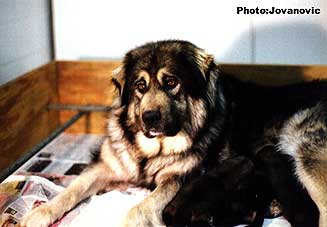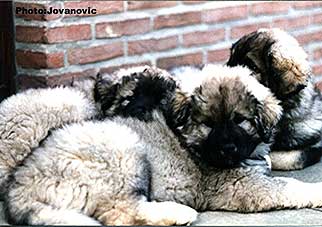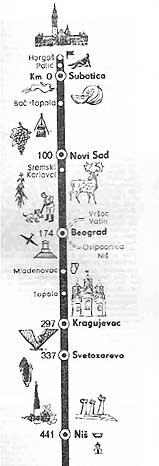 Beginning
of October 1997 we went to mate Seka and our destination was the town of
Nis, the military kennel. The happy chosen one was Cal, one of the beautiful
Yugoslavian champions, though of modest height. Cal had undergone the radiological
control of the hips and his result was “A”, I am still keeping
his X-rays today.
Beginning
of October 1997 we went to mate Seka and our destination was the town of
Nis, the military kennel. The happy chosen one was Cal, one of the beautiful
Yugoslavian champions, though of modest height. Cal had undergone the radiological
control of the hips and his result was “A”, I am still keeping
his X-rays today.Nis has always been a very important transit town. Through Nis leads the road, which through the valleys of south Morava river and Vardar river connects Saloniki and Istanbul with Belgrade and the other which through the valley of Nisava river and Marica, leads again to Istanbul. It is one of the main roads in the Balkans. The road was already known in Roman and Byzantine history, when it was called “Via Militaris”. In the Middles Ages it was called Road of Istanbul. Nowadays this important European magisterial road, together with Nis as an important transit town, connects central Europe with Asia Minor. Through Nis lead important land roads and air corridors in the direction of Belgrade, Skopje, Dimitrovgrad, Pristina and Zajecar.
Naissus (roman name for Nis) is for the first time mentioned beginning of the second century. Quoting towns in the province of upper Mesia, Ptolemeius is talking about it as well as other towns, which demonstrates that Naissus clearly developed in the mean time. Naissus is also becoming a military base in the second century.
Naissus is having its zenith and its big economical development in the IV century. Written sources are testifying this wherein this town is mentioned more and more, as well as archeological information, which are very numerous and various for this period. An anonymous writer of the IV century wrote: “In Naissus Constantine the Great was born and educated; he later richly decorated this town”. The origin of Constantine the Great from Naissus has also been mentioned in other sources.
The occupation of Naissus in 441 by the Huns meant the progression and prosperity stop of Naissus. On the ruins of the roman town contemporary Nis has developed.
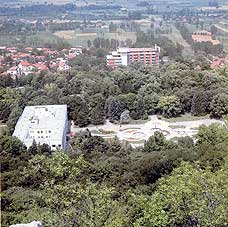
We had difficulties to stay with Seka in a hotel in Niska Banja spa. The Romans already built baths and the whole thermal complex in the II century. Niska Banja is located 10 km from Nis, under the mountain Suva Planina. It is the most radioactive thermal spa in ex-Yugoslavia, the water of the main source has a temperature of 16, 5 to 36, 8°C, the one from “Skolska cesma” (school tap) is 19, 2°C. We were obliged to smuggle Seka because in this region not a single hotel accepted dogs.
It was for Seka the first mating and she had a little bit more than 2,
5 years. When we arrived at the military they took a vaginal smear and
they told us that she was ready for mating. The soldiers brought Cal at
a leash, 3 others seized Seka and they imagined that the mating would
take place in such a conditions. Seka struggled like a lioness and Cal
did not look very interested and there was no chance to see them mating.
Then the veterinary of the ambulance decided to carry out an insemination.
It was done in a very rudimentary way; I will not go into details. If
I recall properly we repeated the procedure once more the day after. During
our stay we had the opportunity to visit the kennel, to assist at the
training of the dogs and to visit the room, which was keeping the archives
of the military kennel and the trophies.
At this occasion we made some pictures, which will follow.
At this occasion we made some pictures, which will follow.
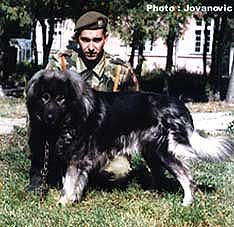
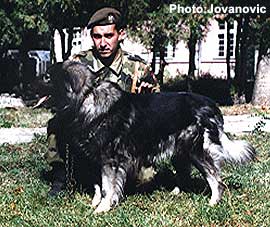
We saw Lej, the father of Cal, still good preserved but with a very light skeleton,
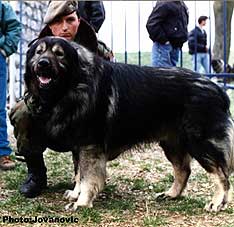
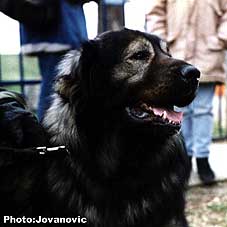
Cal who showed what he could do, such as giving a paw from distance. Cal was not very tall, 70-72 cm, had a rather short body, perfect angles, splendid movements, a beautiful head and rather strong, with big “glasses”. He was holding the head quite high and when he was observing you he did it from a certain height.
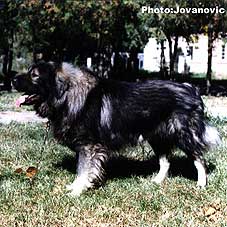
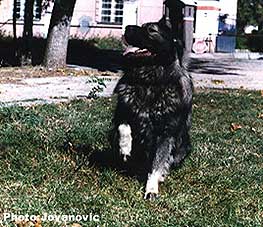
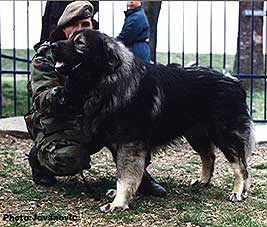
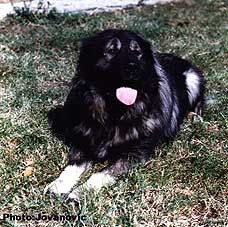
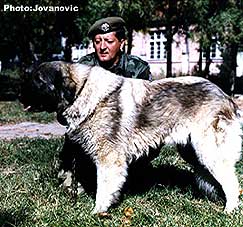
We also took pictures from the most beautiful female, Arsa, who was winning the contests,
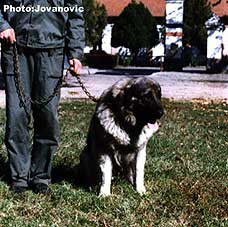
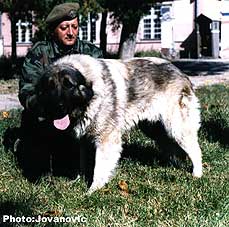
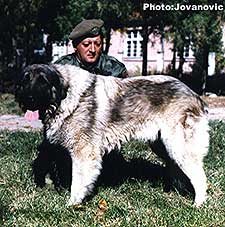
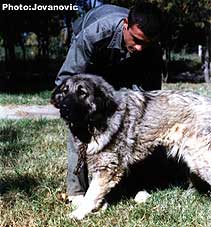
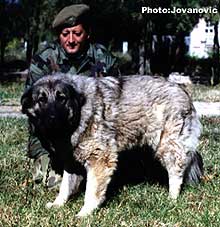
her daughter quite similar strong and tall
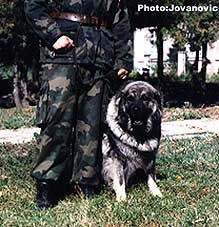
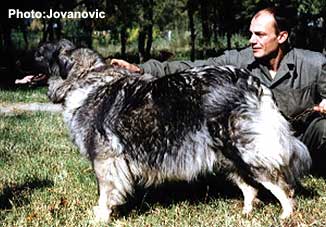
and some other female dogs.
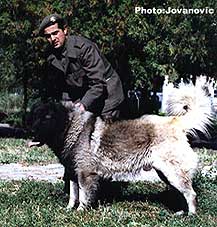
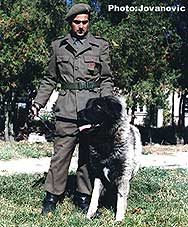
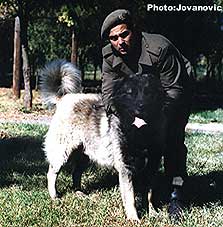
On the way back to Belgrade we visited some very nice monasteries in the neighborhood of town of Krusevac, in the region between west Morava and big Morava rivers. All those monasteries belong through their architecture to the Moravian school. This school was established in a relatively short period, it is counted that this period started with the battle on the river Marica (1371) and ended with the complete fall of Serbia under the Turkish occupation (1459).
The characteristics of this style are: the foundations are in the shape of a cross, with the addition of the apses and the choirs the shape became those of the trefoil; the presence of the exonarthex, the 5 domes of octagonal shape, covered by lead and the walls are made either of stones in combination with bricks or only in stone and then covered with mortar. Most notable are the decorations in the shape of garlands, bows and archivolts. It concerns woven motifs made in a rather deep relief.
The first and the most important church we visited was Lazarica in Krusevac. It is the foundation of Duke Lazar, which he had built between 1377 and 1380.
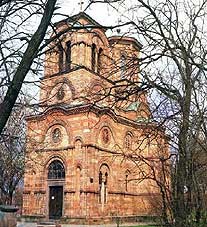
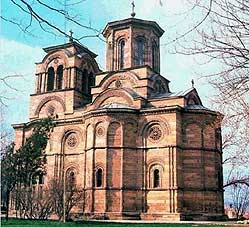 The church is splendid and very rich in ornaments, especially on top of
the windows.
The church is splendid and very rich in ornaments, especially on top of
the windows.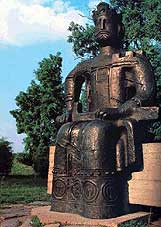
In the park, which is surrounding the church, there is this monument representing the Duke Lazar, the work of the sculptor Mitric .
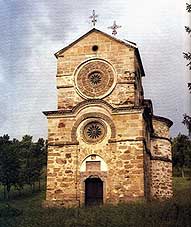
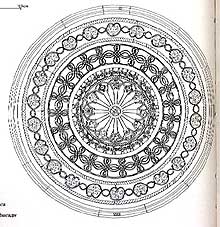
The monastery Naupara is located 12 km from Krusevac and is located at the border of the river Rasina. The monastery was most probably constructed in 1381. It was completely destroyed and renovated in 1835. There are very little written documents about this monastery. We were absolutely fascinated by the beauty of the big and small rosettes on the main façade.
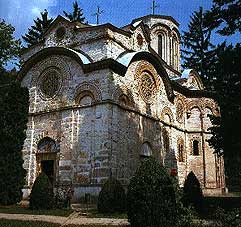
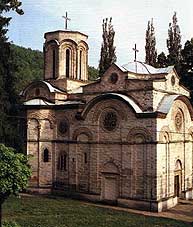 The road then took us to the Monastery Ljubostinja.
The road then took us to the Monastery Ljubostinja.It is located very near the town of Trstenik. It is dedicated to the Ascension of the Virgin and it is the foundation of the Princess Milica. It was built in 1388/1389.
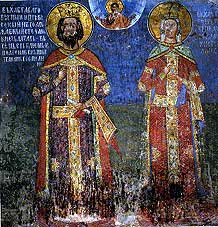
The frescos were painted at the end of the 14th Century by master Makarije. This fresco represents the Duke Lazar and the Princess Milica. After the battle of Kosovo Polje, Princes Milica entered in the monastery to become a nun and spent there the rest of her life. She is also buried there.
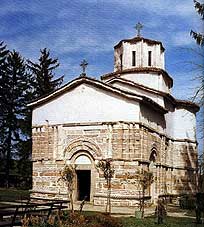
The next monastery to visit was Veluce. The monastery is located 10 km at the southeast of Trstenik. They believe that the church was built at the end of the 14th century and with regard to donators, there are only assumptions because the inscriptions under the frescos are damaged and unreadable.
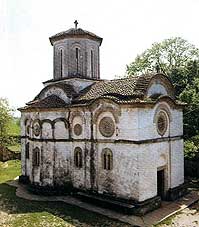
After Veluce we have visited the monastery Rudenica. It is located a few kilometers further from Veluce. It is situated outside the village, at the border of a stream and under a forest hill. It is rather difficult to access. It is assumed to be the foundation of Vuk, the brother of the despot Lazarevic. Different to others, this church has plastered walls and on them you can see rather comic frescos, probably made by the inhabitants of nearby village.
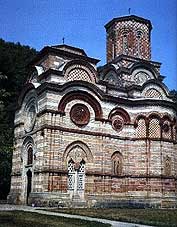
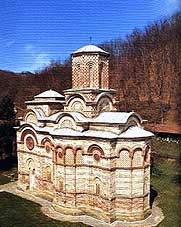
The last and one of the most beautiful monasteries we have visited is Kalenic. It is located at the west of town of Jagodina. The monastery was built in the first half of 15th century. As donators Bogdan and Milica are mentioned, nobility at the service of the despot Stefan Lazarevic.

The experts of the plastic art of Kalenic, agree to say that the interior Portal is the most monumental and the richest portal from the Moravian school.
After the return in Belgrade, I started to worry and to ask myself questions. In the front of the house there were regularly 4-5 stray dogs, gathered together and Seka was obviously very interested by their presence. I could not even take her out for a short indispensable walk. After 2-3 days I have called the military kennel and asked them if I could return to repeat the insemination. We went again down to Nis and luckily otherwise Seka would have not been pregnant.
For the return we chose another itinerary, we took the direction of town of Zajecar. In the very picturesque valley of Crna Reka, not far from Zajecar, behind the soft hills and far away from the looks of accidental travelers, stands already for 17 centuries ruins of old town of Gamzigrad. High walls with huge towers and monumental buildings, which they are protecting, were described during the last century by few rare travelers and lovers of antiques, considering that these are the best preserved remains of roman architecture in Europe.
For quite some time specialized and scientific discussions were lasting about what those mysterious buildings represent. Final solution of this big secret was established by hard archeological research, which was conducted by scientist Dragoslav Srejovic for more than 20 years.
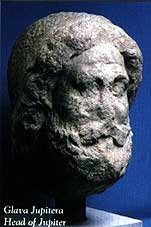
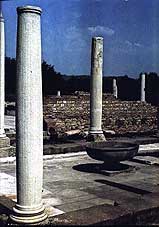
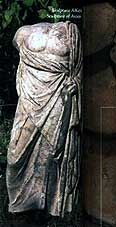
When the monuments shined by the splendid structures, decorated by most beautiful mosaics and sculptures, for that clever and persistent explorer became clear that Gamzigrad could be only one thing – royal palace.
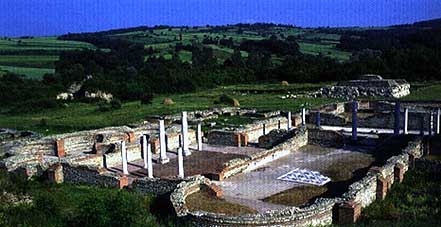
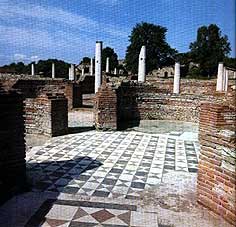
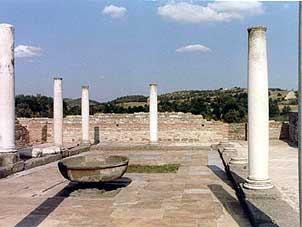
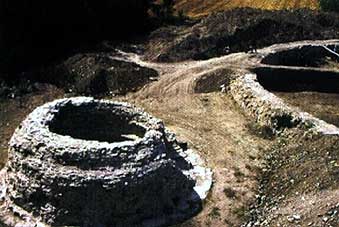
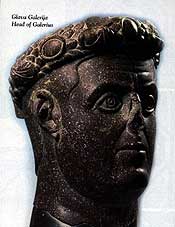 It is in his birthplace in which he was buried as well. Archivolt with inscription
Felix Romuliana,
It is in his birthplace in which he was buried as well. Archivolt with inscription
Felix Romuliana, 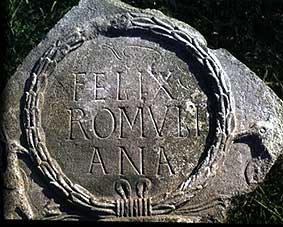 which
was discovered in 1984, proved all the presumptions of Mr. Dragoslav Srejovic
and Gamzigrad finally was put where it belongs – among most important
roman imperial architecture.
which
was discovered in 1984, proved all the presumptions of Mr. Dragoslav Srejovic
and Gamzigrad finally was put where it belongs – among most important
roman imperial architecture.Emperor Galerius, founder of magnificent monument was born in the middle of 3rd century. He was member of lowest class, which was not obstacle for him to become brave soldier and then later courageous and clever military leader who was serving humble the Empire and its reformer Diocletian. Considering that Galerius is the person to whom he could handover the reign of the eastern part of the Empire, Diocletian married him to his daughter in the year 293 and declared him as a co-emperor.
Seka was “super” during all our travels, after a short walk, she was waiting us patiently in the car.
2 months later Seka gave a birth to 5 puppies from which only 2 female and 1 male stayed alive. They are Veca, which stayed with us, Vrska and Vojkan.
